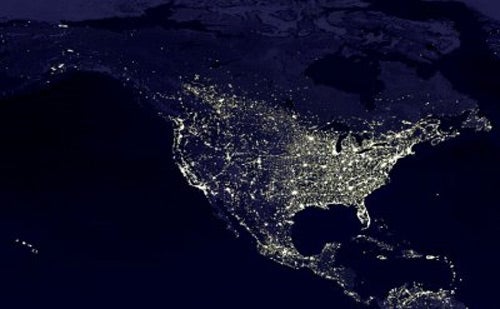A recent university survey estimates two-thirds of the world’s population cannot see the Milky Way’s hazy band stretch across the night sky. Light pollution has turned night into day and has robbed a generation of a star-filled sky. Professional astronomers also are battling the fog of light pollution, which is threatening their research. Now, Quebec astronomers are turning back the clock, returning the night sky across the province to its former glory.
Led by the Mont Megantic Observatory, the largest professional astronomical facility in Quebec, a project is underway to curb the ever-brightening skies surrounding the mountaintop observatory. The astronomers, in connection with governing councils of surrounding towns, are in the process of establishing a 15-mile-wide (25 kilometer) dark-sky preserve centered on the observatory. They also encouraged lawmakers to enact regional stargazing-friendly lighting bylaws. The goal is a 50-percent reduction in light pollution by the end of 2006. They also hope to create a model for other municipalities across the province to follow.
“In 25 years, the light pollution has at least doubled in the area,” says Yvan Dutil, astrophysicist and spokesperson for the dark-sky initiative in Quebec. “Back when the observatory was constructed, in 1978, astronomers needed flashlights to walk around the mountaintop, and now they don’t need them anymore.”
According to Dutil, the Mont Megantic Dark-Sky Preserve is unique in Canada because it’s the only professional observatory that has such a wide protection. Dutil hatched the idea 12 years ago when he was a graduate student studying galactic astronomy. “At that time, I was just coming back from Hawaii, where the night sky is pristine. Upset by the situation in Quebec, I proposed the creation of a dark-sky preservation park around the Mont Megantic Observatory.” The project was announced last week at the annual meeting of the Canadian Astronomical Society held in Montreal.
Sporting a 64-inch (1.63 meter) Ritchey-Chrétien telescope, Mont Megantic is located in Quebec’s Eastern Townships, about a 3 hours’ drive east from Montreal. Université de Montréal and Université Laval in Québec City jointly operate the observatory.
Quebec is one of the most light-polluted regions on Earth. Satellite images taken during winter 1997 show the city of Montreal suffering the same amount of light pollution as New York City, despite having less than one-quarter its population. Even after taking into account the snow-cover reflection, each person emits 3 times as much light as the average American or European.
Unlike more southerly locations, Quebec is blanketed by snow for months during winter. Just as the darkest part of the year rolls around, scientists at Mont Megantic must deal with highly reflective snow. Astronomers don’t expect to be tinkering with Mother Nature anytime soon, but the fight for darker skies is gaining ground. Dutil admits it’s impossible to eliminate the growth of light pollution completely, but hopes the initiative will at least turn the region back to what it was a quarter of a century ago.
The nearby city of Sherbrooke, rapidly growing with a population of 140,000, produces one-third of the light pollution at the observatory. So, in addition to the preserve setting limits on the type and amount of outdoor lighting, 10 p.m. curfews for surrounding businesses and farmers are in effect.
The plan also garnered financing for the replacement of all lighting systems within 15 miles (25 km) of the observatory. The new lights will reduce energy consumption by 40 percent and light pollution by 80 percent. This represents one of the most aggressive actions ever taken to reduce light pollution.
Adding to their arsenal, Dutil and Mont Megantic partnered with the 4,000-member Quebec Federation of Amateur Astronomers. They produced a “how-to” manual on reducing urban light pollution that any city can put into practice. The action plan goes beyond just making a case against light pollution. It also points out two benefits of adaptive lighting systems: improved road safety and energy efficiency.
Already, great strides have been made by the province’s two largest cities, Montreal and Quebec City. They will begin implementing the group’s illumination plan next year. According to Dutil’s calculations, if 80 percent of Montreal’s light pollution is eliminated, 10 times more stars would be visible. But Dutil cautions urban stargazers in the province not to expect a significant improvement in night-sky conditions for another decade.










